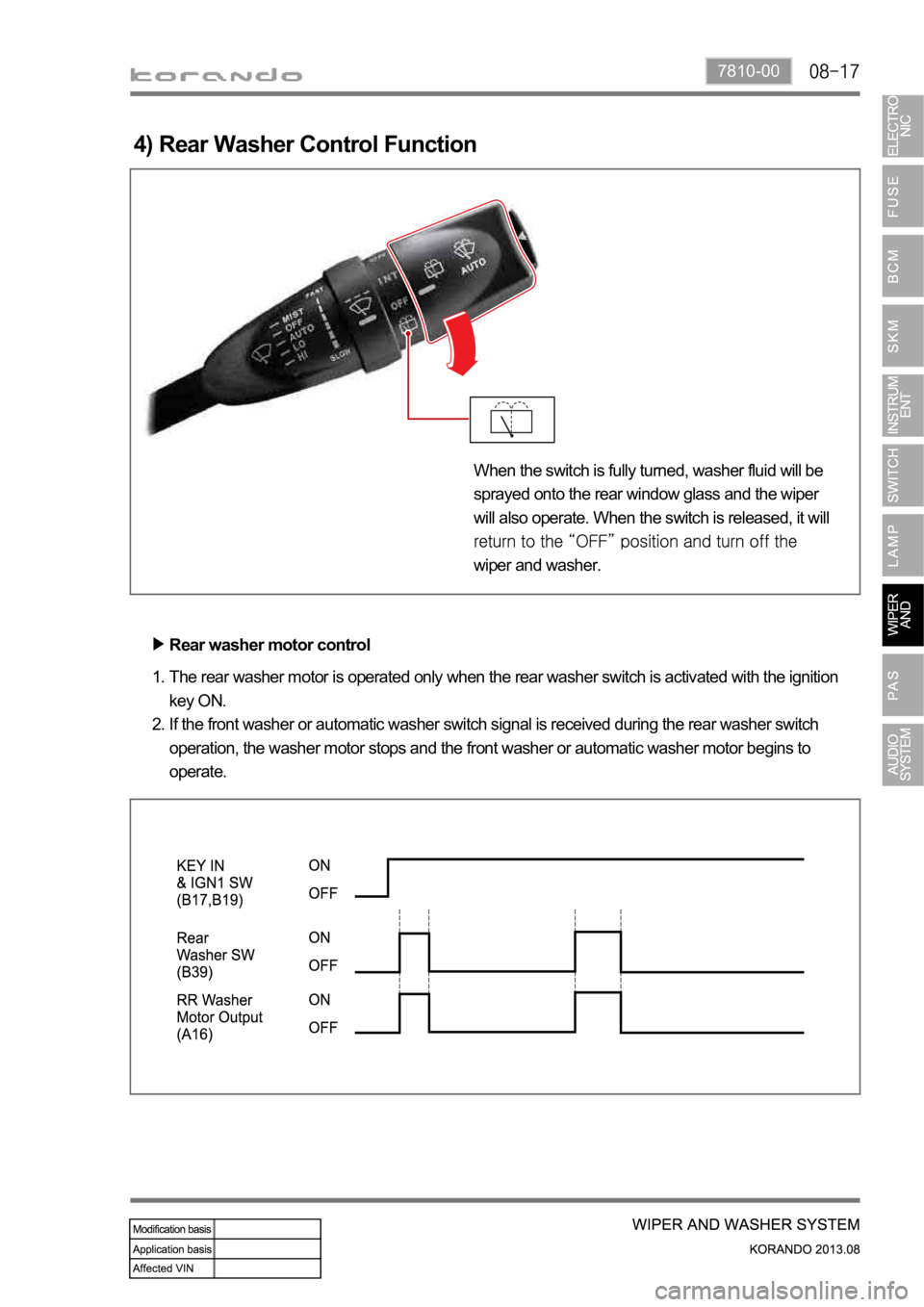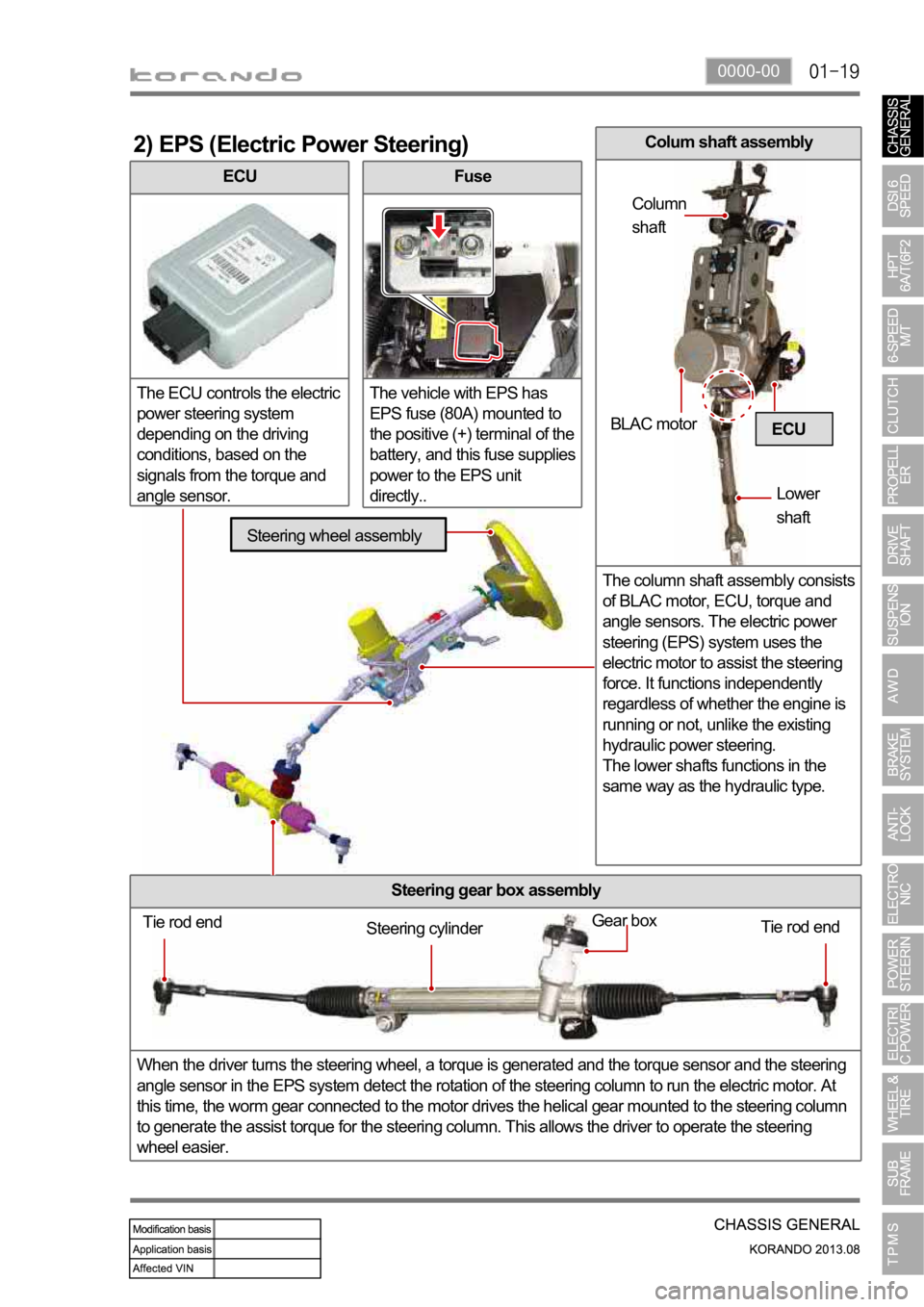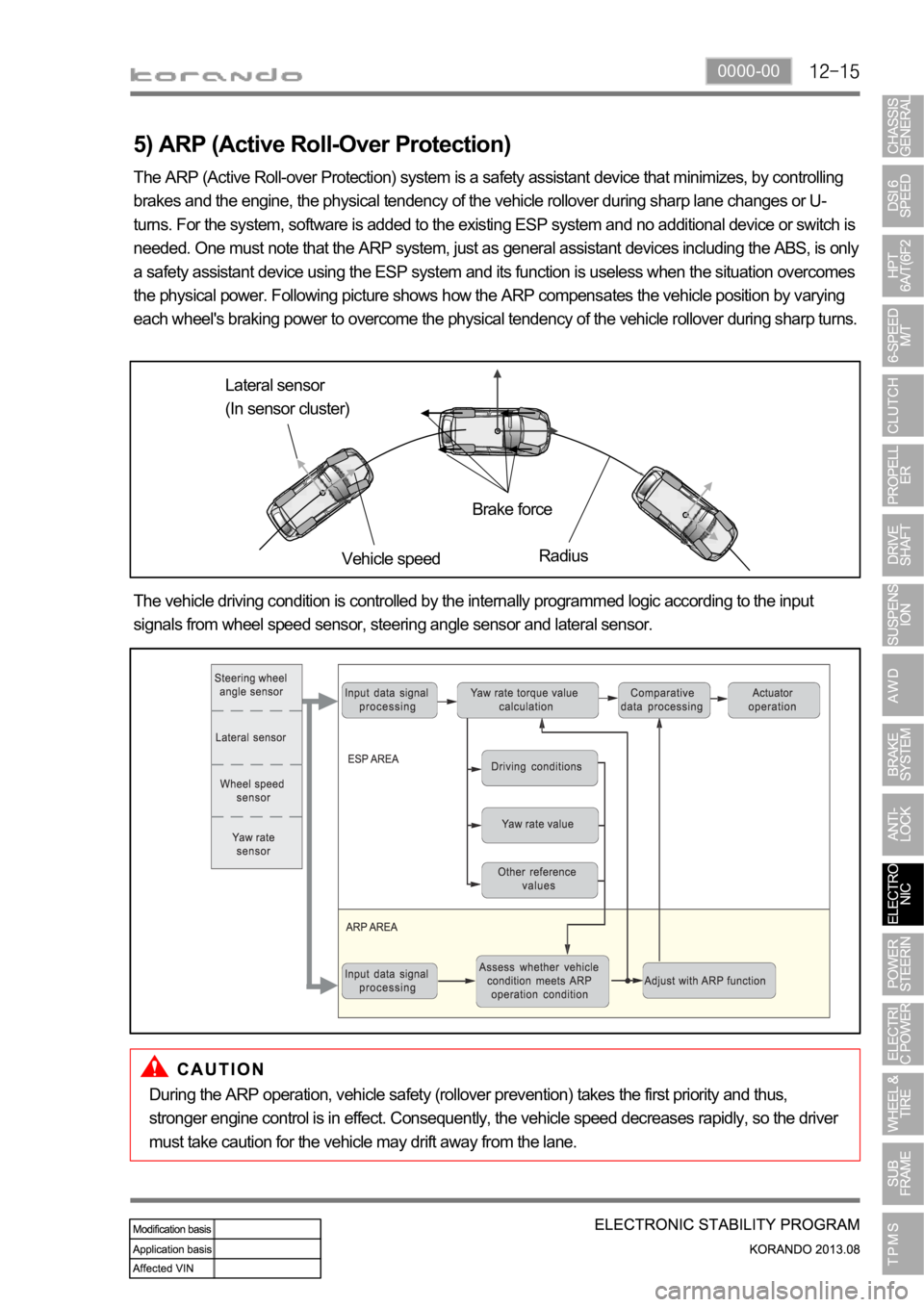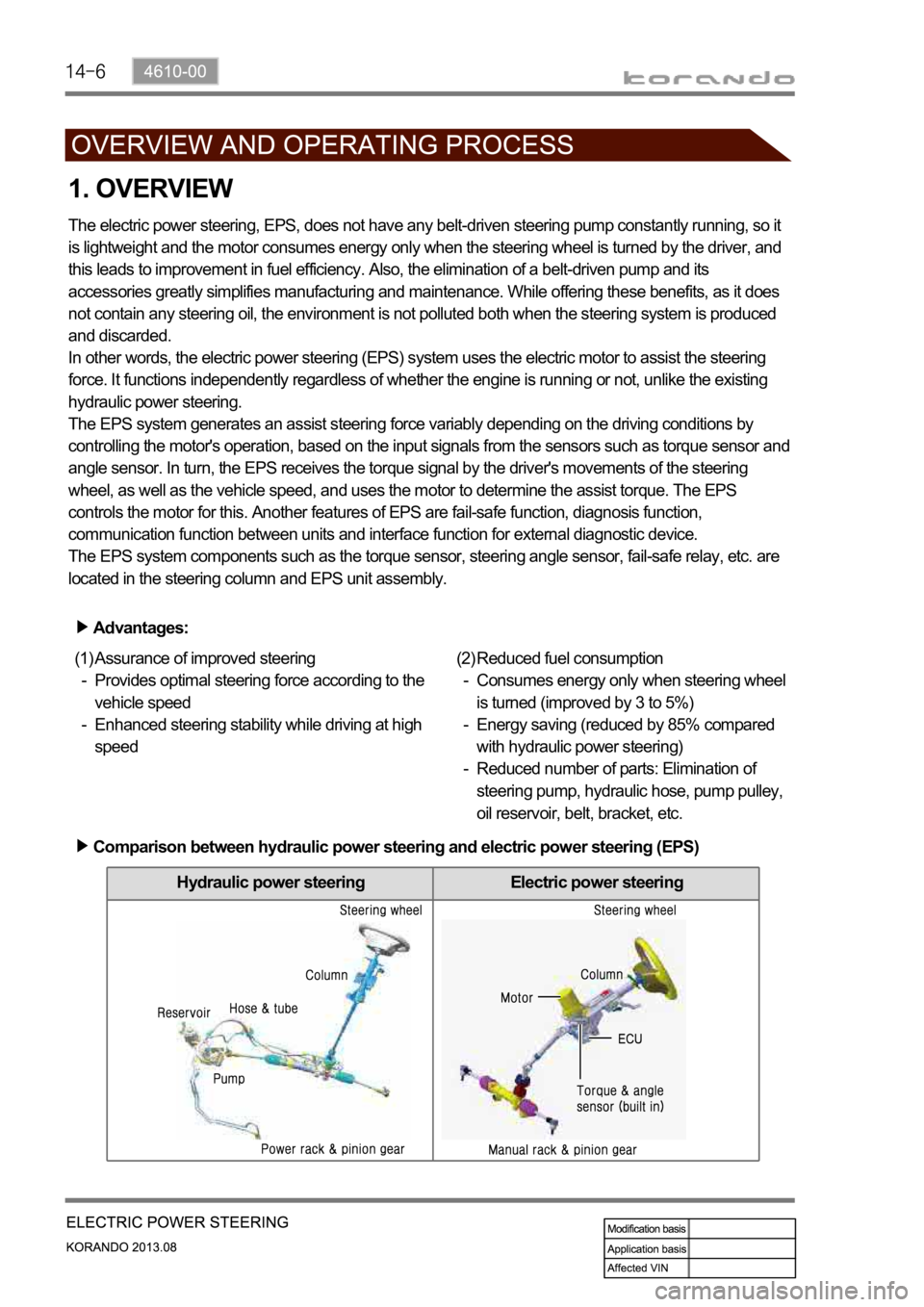turn signal SSANGYONG KORANDO 2013 Owners Manual
[x] Cancel search | Manufacturer: SSANGYONG, Model Year: 2013, Model line: KORANDO, Model: SSANGYONG KORANDO 2013Pages: 1336, PDF Size: 92.18 MB
Page 941 of 1336

7810-00
4) Rear Washer Control Function
The rear washer motor is operated only when the rear washer switch is activated with the ignition
key ON.
If the front washer or automatic washer switch signal is received during the rear washer switch
operation, the washer motor stops and the front washer or automatic washer motor begins to
operate. 1.
2.Rear washer motor control
When the switch is fully turned, washer fluid will be
sprayed onto the rear window glass and the wiper
will also operate. When the switch is released, it will
wiper and washer.
Page 944 of 1336

If the intermittent/automatic wiper switch is in "ON" position, the wiper motor does not operate even
when turning the ignition switch to ON from OFF position.
When the INT/AUTO wiper switch is turned on from off with the ignition switch ON, the wiper is
operated at low speed for the 1st cycle regardless of the rain sensor signals. After that, if the
INT/AUTO wiper switch is turned on from off, the wiper cycles one time at low speed only when the
rain sensor detects the presence of rain. 1.
2.
(2) Power-up reminder wiper
Page 948 of 1336

When the wiper speed control switch is turned to step 3 from step 4 the wiper motor cycles one time
at low speed, provided that the BCM receives a communication error signal from the rain sensor uni
t
with IGN ON and the INT/AUTO switch ON. 2.
When the wiper speed control switch is turned to step 2 from step 3 the wiper motor cycles one
time at low speed, provided that the BCM receives a faulty sensor signal from the rain sensor unit
with IGN ON and the INT/AUTO switch ON. 1.
(6) For faulty rain sensor
Page 952 of 1336

Shift lever
IP display (SVC only)
sensors in the rear bumper detect the distance to any obstacle. The PAS detects the returning signals
reflected to the obstacles at regular intervals when the vehicle is parked to indicate the display and alarm
for the distance between the obstacles by phase so as to allow the driver easy parking by securing safe
distance.
1. OVERVIEW
Buzzer for PAS
Buzzer sounds using instrument
cluster buzzer
Rearview camera
Page 958 of 1336

4. OUTPUT SPECIFICATIONS FOR SENSOR SELF-
DIAGNOSIS BUZZER SOUND
Fail condition (However, no obstacle should be within 30 cm)
1. The signal wire is open
2. The power wire (+ and -)is open -Conditions to "FAIL" in sensor diagnosis
Buzzer interval during self diagnosis
Timeout processing time for buzzer interval after measuring distance/self diagnosis: 600 ms
- If timeout is reached, the PAS returns to undetected condition.
Process while re-inputting
- After timeout, the process is performed normally if the signal required for display is received
from beginning to end. (not detectable if the signal is received in the midst of process) 1.
2.Exception/error handling
Self diagnosis is performed once when the ignition is switched on (gear shift lever in "R" position). If the
system is defective (Fail) due to open sensor or communication problem, the information for the failed
sensor is displayed as buzzer sound.
If it is normal, the warning buzzer sounds for 60 ms.
Page 997 of 1336

0000-00
ECU
The ECU controls the electric
power steering system
depending on the driving
conditions, based on the
signals from the torque and
angle sensor.
2) EPS (Electric Power Steering)
Fuse
The vehicle with EPS has
EPS fuse (80A) mounted to
the positive (+) terminal of the
battery, and this fuse supplies
power to the EPS unit
directly..
Steering gear box assembly
When the driver turns the steering wheel, a torque is generated and the torque sensor and the steering
angle sensor in the EPS system detect the rotation of the steering column to run the electric motor. At
this time, the worm gear connected to the motor drives the helical gear mounted to the steering column
to generate the assist torque for the steering column. This allows the driver to operate the steering
wheel easier.
ECU
Tie rod end
Tie rod end Gear boxSteering cylinder
Steering wheel assembly
BLAC motor
Lower
shaft Column
shaft
Colum shaft assembly
The column shaft assembly consists
of BLAC motor, ECU, torque and
angle sensors. The electric power
steering (EPS) system uses the
electric motor to assist the steering
force. It functions independently
regardless of whether the engine is
running or not, unlike the existing
hydraulic power steering.
The lower shafts functions in the
same way as the hydraulic type.
Page 1132 of 1336

0000-00
5) ARP (Active Roll-Over Protection)
The ARP (Active Roll-over Protection) system is a safety assistant device that minimizes, by controlling
brakes and the engine, the physical tendency of the vehicle rollover during sharp lane changes or U-
turns. For the system, software is added to the existing ESP system and no additional device or switch is
needed. One must note that the ARP system, just as general assistant devices including the ABS, is only
a safety assistant device using the ESP system and its function is useless when the situation overcomes
the physical power. Following picture shows how the ARP compensates the vehicle position by varying
each wheel's braking power to overcome the physical tendency of the vehicle rollover during sharp turns.
Lateral sensor
(In sensor cluster)
Vehicle speedBrake force
Radius
The vehicle driving condition is controlled by the internally programmed logic according to the input
signals from wheel speed sensor, steering angle sensor and lateral sensor.
During the ARP operation, vehicle safety (rollover prevention) takes the first priority and thus,
stronger engine control is in effect. Consequently, the vehicle speed decreases rapidly, so the driver
must take caution for the vehicle may drift away from the lane.
Page 1135 of 1336

The BCM flashes the emergency auto hazard flasher with interval of 1.25 times/sec.:
The emergency hazard flasher does not operate if the vehicle speed is over 50 km/h when the
emergency stop signal is received.
The emergency hazard flasher operates if the vehicle speed is 50 km/h or lower when the
emergency stop signal is received.
When vehicle speed increases more than 10 km/h above the speed when the signal is received
during operation by emergency braking signal, the emergency hazard flasher stops operation.
When turning emergency hazard flasher switch OFF during operation by emergency braking signal,
it stops operation.
It is deactivated automatically 10 seconds after if items 2) and 3) above are not met during operation
by emergency braking signal.
If multi-function automatic hazard flasher signal is received during operation by emergency braking
signal, it will be overridden. -
-
-
-
-
-
Page 1153 of 1336

Hydraulic power steering Electric power steering
1. OVERVIEW
The electric power steering, EPS, does not have any belt-driven steering pump constantly running, so it
is lightweight and the motor consumes energy only when the steering wheel is turned by the driver, and
this leads to improvement in fuel efficiency. Also, the elimination of a belt-driven pump and its
accessories greatly simplifies manufacturing and maintenance. While offering these benefits, as it does
not contain any steering oil, the environment is not polluted both when the steering system is produced
and discarded.
In other words, the electric power steering (EPS) system uses the electric motor to assist the steering
force. It functions independently regardless of whether the engine is running or not, unlike the existing
hydraulic power steering.
The EPS system generates an assist steering force variably depending on the driving conditions by
controlling the motor's operation, based on the input signals from the sensors such as torque sensor and
angle sensor. In turn, the EPS receives the torque signal by the driver's movements of the steering
wheel, as well as the vehicle speed, and uses the motor to determine the assist torque. The EPS
controls the motor for this. Another features of EPS are fail-safe function, diagnosis function,
communication function between units and interface function for external diagnostic device.
The EPS system components such as the torque sensor, steering angle sensor, fail-safe relay, etc. are
located in the steering column and EPS unit assembly.
Advantages:
Assurance of improved steering
Provides optimal steering force according to the
vehicle speed
Enhanced steering stability while driving at high
speed (1)
-
-Reduced fuel consumption
Consumes energy only when steering wheel
is turned (improved by 3 to 5%)
Energy saving (reduced by 85% compared
with hydraulic power steering)
Reduced number of parts: Elimination of
steering pump, hydraulic hose, pump pulley,
oil reservoir, belt, bracket, etc. (2)
-
-
-
Comparison between hydraulic power steering and electric power steering (EPS)
Page 1178 of 1336

4190-00
4. TPMS PRESSURE VALUE DISPLAYING PROCESS
The TPMS ECU receives the tire pressure value from the wheel module through the wireless
transmission once every about 30 seconds and displays the pressure value on the instrument cluster
through CAN line.
Under normal circumstances, it transmits the tire pressure value and temperature value together
with its ID (Identification) once every about 30 seconds to reduce the load on the wheel module's
battery. But, in the event of emergency or situation which should give a warning to the driver, it
transmits the data once every about 1 second. Since the battery consumption will be increased
rapidly until the data transmission interval will be returned to normal after certain length of time,
adjust the tire pressure to the specified one after rectifying the cause.
The tire pressure is displayed through the following sequences, which occur at the same
time.
Wheel module detection
(Auto learning)This is a step which receives an ID signal from the wheel module fitted
to the vehicle. When the wheel module sends the signal about twice
every 1 minute, each wheel module will be identified.
Wheel module mounting
location detection
(Auto location)The TPMS ECU check which wheel module is installed to which tire.